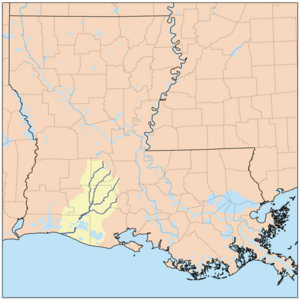Bayou Nezpique facts for kids
The Nezpique River is a small but important river in southern Louisiana, USA. People in the area sometimes call it the "tattooed nose bayou." It flows into the larger Mermentau River. The Nezpique River is about 70 miles (113 km) long. Small boats can travel on its lower 23 miles (37 km).
Contents
Discovering the Nezpique River's History
The land around the Nezpique River was first home to the Atakapa Indian tribe. French settlers later named the river after an Attakapa village nearby. The name "Nezpiqué" means "tattooed nose." This name likely came from the Attakapa people, who were known for their tattooing practices.
In 1791, a man named William Wikoff bought a large piece of land along the river. He bought it from an Attakapa chief named Le Tortue, whose name means "tortoise" in French, and his son Celestine. This shows how early settlers and Native American tribes interacted in the area.
River Depth and Flow
The Nezpique River's depth changes along its path. In the upper part, near Evangeline Parish, it is usually about 7 to 10 feet (2 to 3 meters) deep. As the river flows further downstream, it gets much deeper. In its lower sections, the average depth can be about 35 to 40 feet (11 to 12 meters).
Dams and Reservoirs
To help control the river and its water, several structures have been built.
Upper Bayou Nezpique No 7 Dam
The Upper Bayou Nezpique No 7 Dam was finished in 1970. It is located in Evangeline Parish. This dam was built mainly to help prevent floods. It is made of earth and is about 1,741 feet (531 meters) long. The dam helps manage the river's flow, especially during heavy rains.
Crooked Creek Reservoir
The Nezpique River also feeds into the Crooked Creek Reservoir. This reservoir was created by the Upper Bayou Nezpique No 3 Dam. Construction of this dam was completed in 1974. The Crooked Creek Reservoir is used for two main purposes: flood control and recreation. It has a surface area of about 432 acres (1.75 square kilometers). This means people can enjoy activities like fishing or boating there, while it also helps protect the area from floods.


